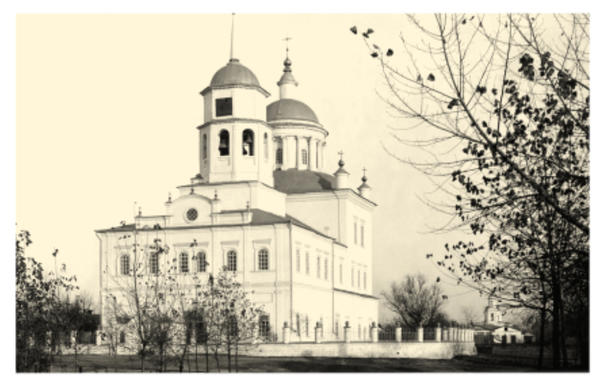Churches and monasteries, their beauty and décor used to be the face of cities in pre-revolutionary Russia, showing their status and standard of living. Human life from birth to death was closely connected with churches: it was here that children were baptized, people were married, the deceased were buried; confessions and communion were regularly administered to purify the soul; here news was heard and agreements were sealed with oaths.
The Smolensky Cathedral on Korochanskaya Street was one of the fifteen functioning churches in Belgorod in the early 20th century. It was erected at the turn of the 18th century, when Belgorod was the center of the administrative and spiritual life of the entire Belgorod fortification line.
On the night of 2 October, 1703, under His Grace Justine, Metropolitan of Belgorod and Oboyan, the regimental sentry Mephody Ivanov stood on watch at the fortress gate. He saw the gate icon of the Blessed Virgin Mary of Smolensk start to gleam and a wax candle kindle from it.
At that time, a chapel of prayer was built on the site, and a wooden Smolensk church was consecrated there in 1705. This effort was promoted in every way possible by the voivode, prince, general and governor Koltsov-Mosalsky. Later the church burned down. In 1727, on the initiative of the Most Reverend Archbishop Peter of Belgоrod, a stone church was laid in its place.
The cathedral is built in the Moscow Baroque style: it is a massive building with two stories, with the structure extending from south to north. The church is adjoined by a one-part oval apse, also of two stories; to the west are the bell tower and a small refectory. Compositionally, this ensemble is typical of the temple architecture of the Sloboda Ukraine and the Russian borderland at the end of the 17th century.
The lower church was consecrated in 1747 by the most holy member of the Governmental Synod, Bishop Porfiry (Kraisky) of Belgorod in the name of the Apparition of the Blessed Virgin of Smolensk Hodegetria. The upper church, in the name of the holy apostles Peter and Paul, was consecrated by Metropolitan Anthony of Belgorod in 1763.
The church was damaged by artillery shells during the Second World War and was nearly blown up in 1958 and 1974, but it survived. In the 1980s it was used as an organ concert hall. In 1991 the church was returned to the community for worship.
The Smolensky Cathedral on Korochanskaya Street was one of the fifteen functioning churches in Belgorod in the early 20th century. It was erected at the turn of the 18th century, when Belgorod was the center of the administrative and spiritual life of the entire Belgorod fortification line.
On the night of 2 October, 1703, under His Grace Justine, Metropolitan of Belgorod and Oboyan, the regimental sentry Mephody Ivanov stood on watch at the fortress gate. He saw the gate icon of the Blessed Virgin Mary of Smolensk start to gleam and a wax candle kindle from it.
At that time, a chapel of prayer was built on the site, and a wooden Smolensk church was consecrated there in 1705. This effort was promoted in every way possible by the voivode, prince, general and governor Koltsov-Mosalsky. Later the church burned down. In 1727, on the initiative of the Most Reverend Archbishop Peter of Belgоrod, a stone church was laid in its place.
The cathedral is built in the Moscow Baroque style: it is a massive building with two stories, with the structure extending from south to north. The church is adjoined by a one-part oval apse, also of two stories; to the west are the bell tower and a small refectory. Compositionally, this ensemble is typical of the temple architecture of the Sloboda Ukraine and the Russian borderland at the end of the 17th century.
The lower church was consecrated in 1747 by the most holy member of the Governmental Synod, Bishop Porfiry (Kraisky) of Belgorod in the name of the Apparition of the Blessed Virgin of Smolensk Hodegetria. The upper church, in the name of the holy apostles Peter and Paul, was consecrated by Metropolitan Anthony of Belgorod in 1763.
The church was damaged by artillery shells during the Second World War and was nearly blown up in 1958 and 1974, but it survived. In the 1980s it was used as an organ concert hall. In 1991 the church was returned to the community for worship.


